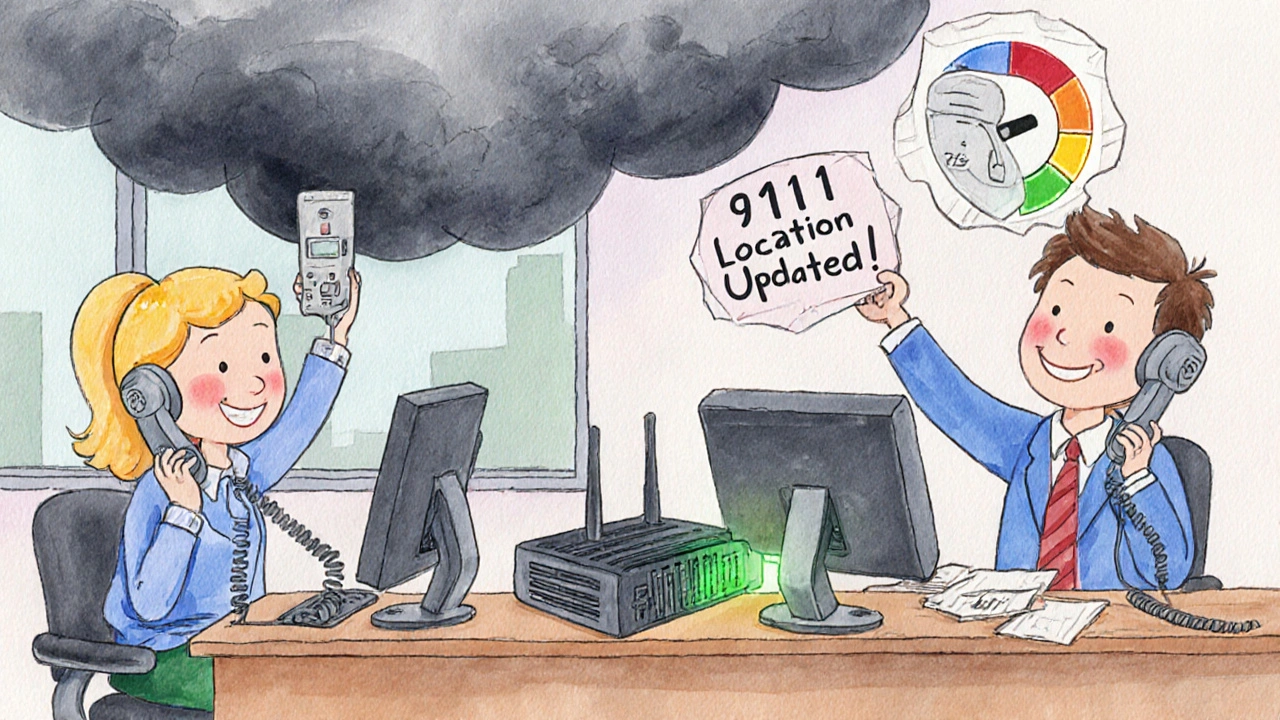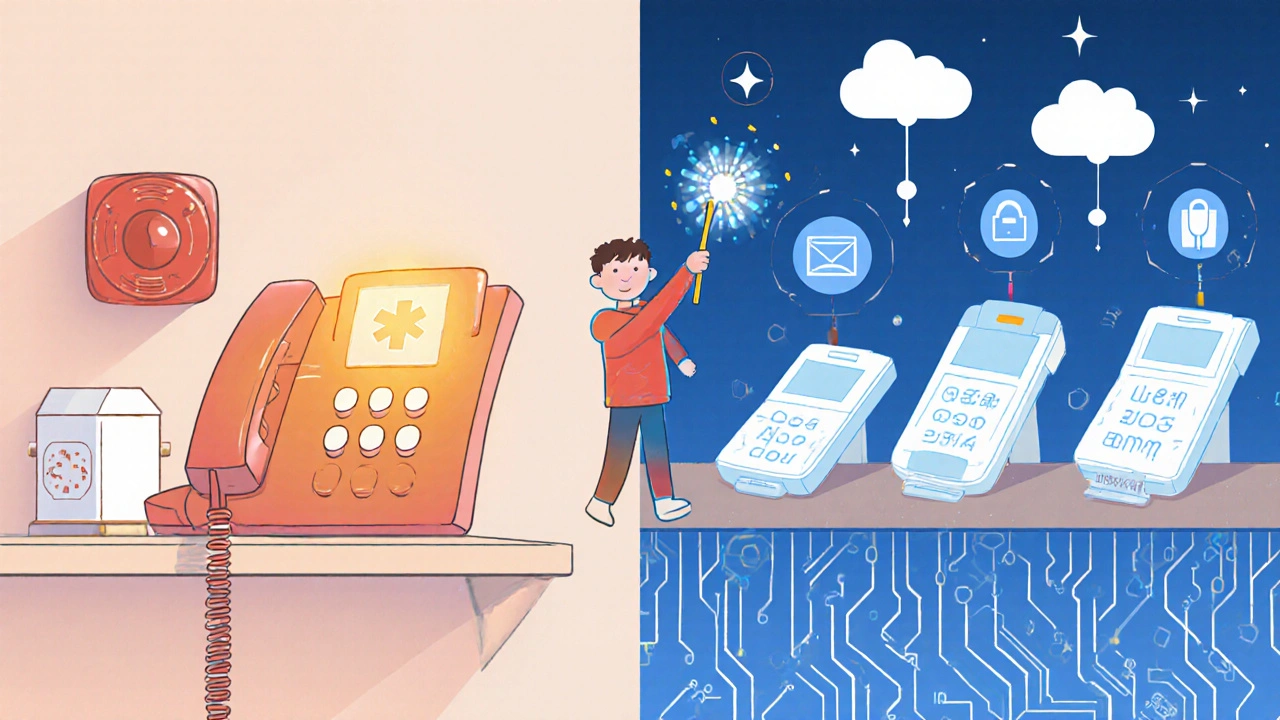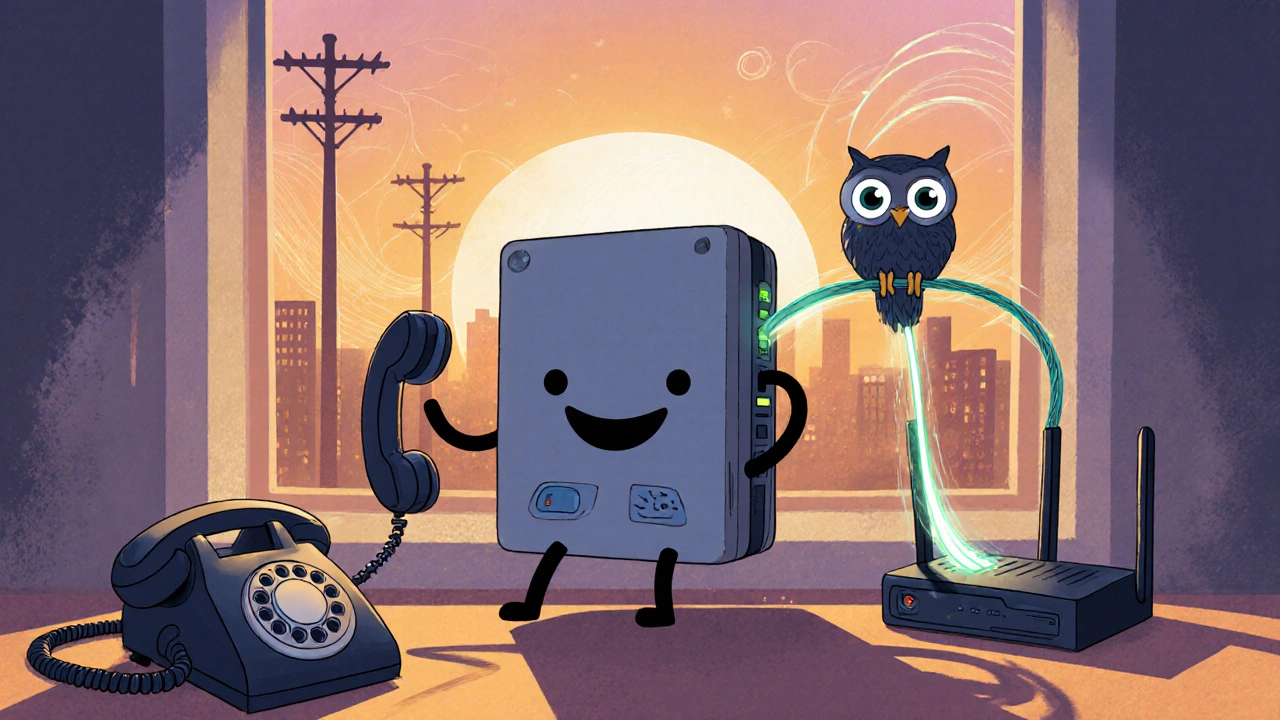By 2025, the old landline phone system is disappearing. In the UK, Germany, and over 20 other countries, the analog phone network - known as PSTN - is being permanently shut down. If your business still relies on traditional phone lines, you’re running on borrowed time. The question isn’t whether to switch to VoIP anymore. It’s how to do it without throwing out everything you already own.
What an ATA Actually Does
An Analog Telephone Adapter (ATA) is a small box that lets your old analog phones, fax machines, and alarm systems keep working - but over the internet. It takes the voice signal from your landline phone, turns it into digital data, and sends it through your Ethernet cable to your VoIP provider. When someone calls you, it does the reverse: turns the digital signal back into the analog sound your phone understands. You don’t need to replace every phone in your office. Plug your existing desk phones into the ATA’s FXS ports, and they work just like before - except now you’re paying VoIP rates. Models like the Grandstream HT812 and Cisco SPA112 are common because they’re simple, reliable, and support modern features like encryption and fax over IP (T.38 protocol). The HT812 even lets you connect two phones at once. The SPA112 uses Power over Ethernet, so you don’t need a separate power adapter.Cost Savings Are Real - But Not Automatic
Switching from landlines to VoIP with an ATA can cut your phone bill by 30% to 50% on domestic calls, and up to 80% on international ones. A small business with 10 employees typically saves $1,200 a year just by making the switch. That’s not theory - it’s from real case studies. But here’s the catch: you still need good internet. Each call needs at least 100 kbps of stable bandwidth. If your internet is slow or gets crowded during meetings, calls drop or sound like underwater robots. Most failures with ATAs aren’t because the device is broken - they’re because the network wasn’t prepared. Businesses that see the best results are the ones who check their upload speed, set up Quality of Service (QoS) on their router, and prioritize voice traffic.Reliability: Landlines Still Win During Power Outages
Landlines have one unbeatable advantage: they work when the power goes out. Your phone doesn’t need electricity because the phone company sends power through the copper wires. VoIP? Not so much. If the power dies, your router, modem, and ATA go offline too. Your phones go silent. That’s why many businesses keep one analog line around - just for emergencies. Or they buy a battery backup (UPS) for their network gear. J.D. Power found that VoIP systems with proper backup can hit 99.9% uptime, close to landline levels. But without it? You’re down. For offices in areas with frequent outages, this isn’t a minor detail - it’s a dealbreaker.Scalability: Add Lines in Minutes, Not Weeks
Adding a new landline used to mean a technician coming out, digging up the yard, running copper wire, and paying $150-$300 per line. Today, adding a new VoIP user costs $5-$15 a month. You plug in a new ATA, log into your provider’s portal, assign a number, and you’re done. No wires. No waiting. This is why businesses with 500+ employees have almost all switched. It’s not just cheaper - it’s faster. If you’re growing, hiring remotely, or opening new offices, VoIP with ATAs scales effortlessly. Landlines? You’re stuck paying for physical infrastructure that doesn’t move.
Fax Machines Still Need Analog - But There’s a Fix
If you still send faxes - for legal docs, medical records, or insurance forms - you’re not alone. But faxing over regular VoIP usually fails. The signal gets chopped up. That’s why T.38 protocol matters. It’s a special code built into better ATAs that lets faxes travel reliably over IP networks. The Patton 4111 and Grandstream HT812 both support T.38. Gartner reports these models achieve 95% fax success rates - way above the 70% you get with basic VoIP setups. If you rely on fax, don’t skip this. And don’t assume your ATA supports it out of the box. Check the specs. Update the firmware. Test it with real documents before you cut your landline.Emergency Calls: 911 Isn’t Guaranteed on VoIP
Here’s a scary truth: not all VoIP providers give you reliable 911 service. The FCC requires them to offer it, but enforcement is patchy. Landlines automatically send your address to emergency responders. With VoIP, you have to manually register your location - and if you move your ATA to a new office or take it home, that address might be wrong. FCC data shows only 85% of VoIP providers deliver accurate E911. Landlines? 98%. If your business handles sensitive operations - a clinic, a nursing home, a fire alarm system - you need to verify your provider’s 911 compliance. Some ATAs let you set a static location, but you still have to update it if you change offices. Don’t assume it works. Test it.Who Should Stick With Landlines?
You might still need analog lines if:- Your security system, medical alert device, or fire alarm only works with analog phone lines (many are certified that way).
- You’re in an area with unreliable internet - and you can’t install a backup connection.
- You’re in a regulated industry (healthcare, finance) where legacy systems can’t be changed without re-certification.

What’s Next for ATAs?
ATA technology isn’t standing still. New firmware updates add features like WebRTC support, AI call analytics, and STIR/SHAKEN caller ID authentication (required by the FCC in June 2024). Grandstream’s upcoming HT8XX Pro series will even connect to IoT devices. But the big driver isn’t innovation - it’s necessity. The PSTN is dying. Statista estimates 420 million analog phones are still in use worldwide. ATAs are the bridge. They’re not the future - they’re the only way to get there without losing your business.Implementation Tips That Actually Work
If you’re ready to switch, here’s what actually helps:- Test your internet speed - upload matters more than download for VoIP.
- Enable QoS on your router to prioritize voice traffic.
- Use T.38 if you fax - and test it before you cancel your landline.
- Register your physical address with your VoIP provider for 911.
- Keep one analog line for critical devices until you confirm they work on VoIP.
- Update ATA firmware regularly - manufacturers fix bugs and add security patches.
Final Call: Don’t Wait for the Shutdown
The analog phone network isn’t going to last forever. In the UK, it’s gone. In Germany, it’s ending in 2027. The writing is on the wall. ATAs aren’t a temporary fix - they’re the standard way forward for businesses that want to keep using their existing phones while gaining the benefits of modern VoIP. You don’t need to replace everything. You don’t need to panic. But you do need to act. Start by testing your network. Pick a reliable ATA. Keep your analog lines for emergencies. And make the move before your provider pulls the plug.Can I use my old landline phone with VoIP?
Yes, with an Analog Telephone Adapter (ATA). Plug your analog phone into the ATA’s FXS port, connect the ATA to your router via Ethernet, and it will work over your VoIP service. Your phone won’t know the difference - it still gets dial tone and rings normally.
Do I need to buy new phones to use VoIP?
No. If you have analog phones or fax machines, you can keep them using an ATA. You only need new IP phones if you want advanced features like video calling, touchscreen interfaces, or direct SIP registration. For most small businesses, ATAs are the cheaper, simpler path.
What’s the best ATA for small businesses?
For most small businesses, the Grandstream HT812 is the top pick. It supports two analog phones, has built-in T.38 fax support, and works with all major VoIP providers. The Cisco SPA112 is also solid if you need Power over Ethernet and only need one phone line. Both are under $70 and have proven reliability.
Why is my fax machine not working with my ATA?
Most likely, T.38 fax protocol isn’t enabled. Check your ATA’s settings and turn on T.38. Also set the fax rate to 14,400 bps. If you’re still having issues, your VoIP provider might not support fax well - switch to one that does, or test with a different ATA. Many users report success after updating firmware to the latest version.
Will my business phone system still work during a power outage?
Only if you have a battery backup (UPS) for your router, modem, and ATA. Without it, your VoIP service goes down when the power fails. Analog landlines still work because they get power from the phone company. For critical operations, keep one analog line as backup or invest in a UPS.
Is VoIP with an ATA secure?
Modern ATAs support SRTP encryption for voice calls and TLS for signaling, making them as secure as any business-grade VoIP system. But security depends on your network. Use strong passwords, update firmware regularly, enable firewall protection, and avoid open ports. If you handle sensitive data (like medical records), ensure your VoIP provider is HIPAA-compliant.
How long does it take to set up an ATA?
Basic setup - plugging in one phone - takes 15-30 minutes. Full configuration, including QoS, T.38, and 911 registration, can take 1-2 hours. Enterprise deployments with multiple locations may take days or weeks, depending on network complexity. Most users report success within a day if they follow the manufacturer’s guide and have stable internet.
Are ATAs being phased out?
No. ATAs are not being phased out - they’re becoming essential. With over 420 million analog devices still in use globally, ATAs are the bridge between legacy systems and modern VoIP. Even as companies move to full IP systems, ATAs will remain critical for connecting fax machines, alarms, and older phones. Industry analysts predict ATAs will stay relevant for at least another decade.
If you’re still on analog lines, you’re not behind - you’re just waiting. The transition isn’t about replacing your phones. It’s about upgrading your connection. With an ATA, you get the reliability you trust and the savings you need - without the disruption.
